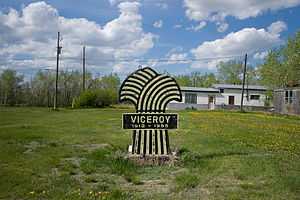Viceroy, Saskatchewan
| Viceroy | |
|---|---|
| Hamlet | |
 | |
 Viceroy | |
| Coordinates: 49°27′37.26″N 105°22′6.01″W / 49.4603500°N 105.3683361°WCoordinates: 49°27′37.26″N 105°22′6.01″W / 49.4603500°N 105.3683361°W | |
| Country | Canada |
| Province | Saskatchewan |
| Region | Saskatchewan |
| Census division | 3 |
| Rural Municipality | Excel |
| Area | |
| • Total | 1.15 km2 (0.44 sq mi) |
| Population (2006) | |
| • Total | 30 |
| • Density | 26.0/km2 (67/sq mi) |
| Time zone | CST |
| Postal code | S0H 4H0 |
| Area code(s) | 306 |
Viceroy is a hamlet in Excel Rural Municipality No. 71, Saskatchewan, Canada. The population was 25 at the 2011 Census. The hamlet previously held the status of a village until May 10, 2002.
Demographics
With a population of approximately 30 people, Viceroy seems poised for a comeback, all lots have currently been sold and the local real estate market has picked up with the oil and Potash boom in Saskatchewan and Alberta.
Prior to May 10, 2002, Viceroy was incorporated as a village, and was restructured as a hamlet under the jurisdiction of the Rural municipality of Excel on that date.[1]
| ||||||||
Location
Viceroy is located 7 km south of the historic Red Coat Trail on highway 705 to the north of Willow Bunch Lake adjacent to the famous Big Muddy Valley.
Services
Once a bustling community with two schools, two restaurants, Klemenz Poolroom and bowling alley, a theatre and many other businesses. After two fires in the past century the community has shrunk to a much smaller scale. Viceroy still boasts the Viceroy Co-op which in a sense is the local "general store" offering grocery staples, tools, feed, hardware, parts, auto repair and petroleum sales.
The RM of Excel No. 71, office is located on main street with the equipment yard/shop to the south. Bengough Credit Union also operates a branch in Viceroy.
Centennial
Viceroy was incorporated in 1912.
See also
- List of communities in Saskatchewan
- Hamlets of Saskatchewan
References
- ↑ "Restructured Villages". Saskatchewan Ministry of Municipal Affairs. Archived from the original on March 25, 2008. Retrieved 2008-02-10.
- ↑ "2011 Community Profiles". Canada 2011 Census. Statistics Canada. July 5, 2013. Retrieved 2011-02-24.
External links
 |
Crane Valley | Ormiston | Kayville |  |
| Verwood | |
Horizon | ||
| ||||
| | ||||
| Willow Bunch | Harptree | Bengough |
| |||||||||||||||||